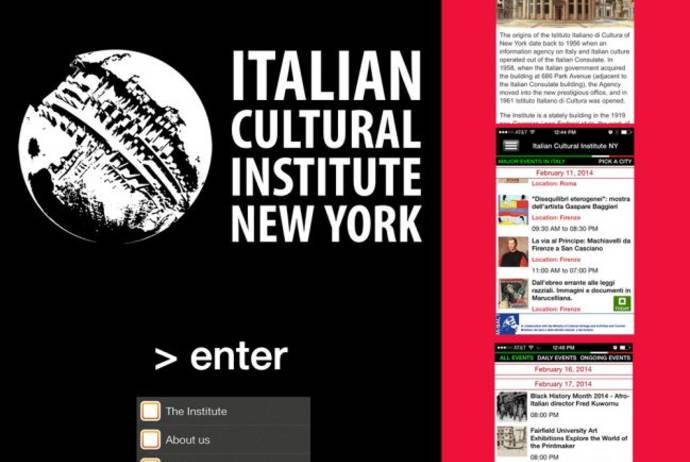It's his last day as director of the Italian Cultural Institute of New York. After being at its helm for the past four years, Professor Riccardo Viale bids farewell to the Park Avenue building that is an incredibly important center of promotion of Italian culture, in a so-called institutional way.
We go meet him to say goodbye and to hear a brief account and some considerations on the job of spreading Italian culture through the Institution he has directed. We start with what's new, something he has launched right on the last day of his mandate. He leaves “it” behind for his successor and for all those who love Italian culture.
He is holding his iPhone while he proudly tells us: “I end my mandate by introducing an innovative contribution. This is an App that allows users to access the calendar of events at the Italian Cultural Institute, but that's not all, it also allows them to check out cultural initiatives that take place in Italy.”
We ask him why he has decided to develop this specific App and what has motivated him to extend the range of information provided to events that are not taking place only in New York City but throughout Italy.
“I've always believed that the Cultural Institute must become the hub of the very best of Italian culture. Its duty is not only that of informing people of what is going on in New York but also of what is happening back in Italy. The Institute can become the go-to information channel for Americans interested in all that is Italian.”
Basically a cultural bridge leading American citizens to Italy ...
“By law, the Institute cannot plan American events in Italy, the mandate does not allow, in any way, the organization of foreign initiatives. Still, I believe that it should be able to carry out some projects that are directly connected to Italy. That's why, for example, during the years of my mandate, I have organized awards and initiatives for Italy's youth. Young people came to New York thanks to the awards we have created. Then they returned to Italy... in this was, we can say that they have walked on that cultural bridge we mentioned earlier.”
Riccardo Viale is happy to have given his contribution to alter, in a certain way, the American perception of Italian culture.
“Through the events we have organized and supported, we have succeeded in proving that Italian culture is not only limited to the Classical period, to the Renaissance and the Baroque.”
What is the biggest challenge in promoting Italian culture?
“This is exactly it... having Americans see our contemporaneity and stop categorizing Italian culture as something of the past. The Italy of today is indeed a country that is full of cultural excellence. An example?
Proving that contemporary Italian art is extremely important is no easy feat, but something is indeed changing. The success of auctions held in New York and London prove that art from the postwar period is getting the attention it deserves.”
We tell him there are going to be, for the first time ever in New York, two shows, at the same time, on Italian futurism. One at CIMA, featuring the work of Fortunato Depero, and one at the Guggenheim Museum.
“Exactly. And I am proud to say that next year there will be a solo exhibition of Burri's work. I suggested it back in 2010, four years ago. It will be the confirmation of a great Italian artist.”
We change topics, and we move on to something a bit less pleasant... the small budget allocated to the Cultural Institute. We are surprised by the lack of complaints on Viale's part.
“Definitely the funding from Italy is rather small, but if you collaborate with other institutions costs are cut down, then if you organize fund raising events with other companies you can get good results. We have some funds left, we are not in debt but rather the opposite... and we've held at least three events a week.”
Riccardo Viale has also been the creator, together celebrated designer Massimo Vignelli, of LaFondazioneNY. They both have strongly supported the necessary “exchange of today's youngsters.” “It is important to import American talents back to our country, and to give prominence to Italians looking for recognition in the United States.”
Created less than a year ago, LaFondazioneNY, has already organized several initiatives, among them we find: The Gotham Prize 2013, the Top Young Industrial Designers Prize, the Young Italian Filmmakers Prize 2013 and the ISNAFF Award for the Humanities.
“LaFondazioneNY keeps going strong.” Viale tells us, “It was created to support Italian cultural initiatives, especially those linked to the Institute. We are now living through a moment of evolution. We will promote American cultural events in Italy. We will work bilaterally, especially through the participation of our youth and by organizing cultural exchange programs where Americans can get specific training in Italian centers of excellence.”
We are back where we started, even when talking about LaFondazioneNY's mission, we touch that concept that is so dear to Viale because it has been at the core of his work as director.
There is the need of a cultural bridge between Italy and the United States, a bridge that is nourished by human resources. There is the need of a continuous cultural exchange between the two countries
-------------------
iPhone App of the Italian Cultural Institute of New York
The application informs on the Institute, its history and its activities and presents the complete and updated calendar of events organized in New York.
Particularly innovative: thanks to an agreement with Italy's Ministry of Arts and Culture (MiBAC), the app will also offer a calendar titled "Main Events in Italy": a selection of the major events organized or sponsored by the Ministry of Culture in major Italian cities.
A perfect tool both for the "Italophiles" of New York and for the American tourist who visits Italy.








































